- Home
- Mary Roach
Packing for Mars: The Curious Science of Life in the Void Page 5
Packing for Mars: The Curious Science of Life in the Void Read online
Page 5
THE FIRST AEROSPACE isolation chambers held just one man. The Mercury and Vostok psychiatrists didn’t worry about crew members getting along with one another; the flights were a few hours or, at most, a couple days long, and the astronauts flew solo. What the psychiatrists worried about was space itself. What happens to a man alone in a silent, black, endless vacuum? To find out, they tried to approximate space here on Earth. Researchers at the Aero-medical Research Laboratory at Wright-Patterson Air Force Base soundproofed a 6-by-10-foot commercial walk-in freezer, put a cot, some snacks, and an enamel chamber pot inside, and turned off the lights. A three-hour stint in the isolation chamber became one of the Mercury astronaut qualifying tests. One account I read, by a Mercury aspirant named Ruth Nichols, described it as the toughest test the candidates endured. Some male pilots, Nichols said, “responded violently” after only a few hours.
Colonel Dan Fulgham was in charge of the Wright-Patterson tests. He doesn’t recall any Mercury candidates becoming violent or otherwise “losing it” during their isolation test. He recalls them using it to catch up on sleep.
The researchers soon began to realize that sensory deprivation was a poor approximation of spaceflight. Space is black, but there’s plenty of sunlight, and the capsules would be lighted. Radio contact would be possible much of the time. Claustrophobia and solitude were the more salient concerns, especially on a longer mission. That is why, in 1958, an airman from the Bronx, named Donald Farrell, undertook a two-week pretend moon mission in the One-Man Space Cabin Simulator at the School of Aviation Medicine, at Brooks Air Force Base in Texas. A Time magazine article described his (sadly long-lost) diary as being increasingly obscenity-laden, but in newspaper interviews he complained only that he missed cigarettes and forgot his comb. Farrell’s greatest hardship, by my reckoning, was the recording of “Love Is a Many-Splendored Thing” and other “soft music” piped into the simulator.
In retrospect, it was silly to think that the experience of traveling in space could be approximated by a repurposed walk-in freezer.
To find out what would happen to a man alone in the cosmos, at some point you just had to lob one up there.
STAR CRAZY
Can Space Blow Your Mind?
Yuri Gagarin stands on a pedestal two stories high, in a patch of grass by a Moscow thoroughfare. You can tell at a distance that it’s him by the way his arms are posed—out away from his sides, fingers pressed together, in the manner of the flying superhero. From the base of the monument, looking up, you cannot see the head of the first man in space, just the heroic chest and the tip of the nose protruding beyond it. I’m joined by a man in a black shirt with a bottle of Pepsi under one arm. His head is lowered, which I take to be a gesture of respect until I see that he is clipping his fingernails.
Nationalist glory aside, Gagarin’s 1961 flight was primarily a psychological achievement. His task was simple, though by no means easy: Climb inside this capsule and let us blast you, alone and at great peril, past the borderline of space. Let us catapult you into an airless, lethal nothingness, where no man has ever been. Whip around the planet, and then come down and tell us what it was like for you.
There was a great deal of conjecture at the time—both at the Soviet space agency and at NASA—about the unique psychological consequences of breaching the cosmos. Would hurtling into “the black,” as pilots used to call it, blow the astronaut’s mind? Hear the ominous words of psychiatrist Eugene Brody, speaking at the 1959 Symposium on Space Psychiatry: “Separation from the earth with all of its unconscious symbolic significance for man,…might in theory at least be expected…to produce—even in a well-selected and trained pilot—something akin to the panic of schizophrenia.”
There was worry that Gagarin might come unhinged and sabotage the history-making mission. It was enough of a worry that the powers-that-be locked the manual controls of the Vostok capsule before liftoff. What if something went awry and communications went dead and Pilot-Cosmonaut #1 needed to take control of the capsule? His superiors had thought about that too, and seemingly turned to game show hosts for advice. Gagarin was given a sealed envelope containing the secret combination to unlock the controls.
The concerns were not altogether fatuous. In a study published in the April 1957 issue of Aviation Medicine, 35 percent of 137 pilots interviewed reported having experienced a strange feeling of detachment from Earth while flying at high altitudes, almost always during a solo flight. “I feel like I have broken the bonds from the terrestrial sphere,” said one pilot. The phenomenon was pervasive enough for psychologists to give it a name: the breakaway effect. For a majority of these pilots, the feeling wasn’t one of panic, but of euphoria. Only 18 of the 137 characterized their feelings as fear or anxiety. “It seems so peaceful, it seems like you are in another world.” “I feel like a giant.” “A king,” said another. Three commented that they felt nearer to God. A pilot named Mal Ross, who set a series of altitude records in experimental aircraft in the late 1950s, twice reported an eerie “feeling of exultation, of wanting to fly on and on.”
The year the Aviation Medicine article ran, Colonel Joe Kittinger ascended to 96,000 feet in an upright, phone-booth-sized sealed capsule suspended beneath a helium balloon. With his oxygen dangerously low, Kittinger was ordered by his superior, David Simons, to begin his descent. “COME AND GET ME,” replied Kittinger, letter by letter in Morse code. Kittinger says it was a joke, but Simons didn’t take it that way. (Morse code has always been a tough medium for humor.) In his memoir Man High, Simons recalls thinking that “the weird and little understood breakaway phenomenon could be taking hold of Kittinger’s mind,…that he…was gripped in this strange reverie and was hellbent on flying on and on without regard for the consequences.”
Simons compared the breakaway phenomenon to “the deadly raptures of the deep.” “Rapture of the deep” is a medical condition—a feeling of calm and invulnerability that can steal over a diver, usually at depths below 100 feet. It is more prosaically known as nitrogen narcosis, or as the Martini Effect (one drink for every 33 feet below 65 feet). Simons speculated that one day soon aerospace physicians would be talking about a condition “known as the deadly rapture of space.”*
He was right, though NASA preferred the less flowery term “space euphoria.” “Some NASA shrinks,” wrote astronaut Gene Cernan in his memoir, “had warned that when I looked down and saw the Earth speeding past so far below, I might be swamped by space euphoria.” Cernan would soon be undertaking a spacewalk—history’s third—during Gemini IX. The psychologists were nervous because the first two spacewalkers had expressed not only an odd euphoria but a worrisome disinclination to go back inside the capsule. “I felt excellent and in a cheerful mood and reluctant to leave free space,” wrote Alexei Leonov, the first human to, in 1965, float freely in the vacuum of space, attached to his Vokshod capsule by an air hose. “As for the so-called psychological barrier that was supposed to be insurmountable by man preparing to confront the cosmic abyss alone, I not only did not sense any barrier, but even forgot that there could be one.”
Four minutes into NASA’s first spacewalk, Gemini IV astronaut Ed White gushed that he felt “like a million dollars.” He struggled to find the words for it. “I’ve…it’s just tremendous.” There are moments when the mission transcript reads like the transcript of a 1970s encounter group. Here are White and his commander, James McDivitt, a couple of Air Force guys, after it’s over:
WHITE: That was the most natural feeling, Jim.
McDIVITT:…You looked like you were in your mother’s womb.
NASA’s concern was not that their astronaut was euphoric, but that euphoria might have overtaken good sense. During White’s twenty minutes of bliss, Mission Control repeatedly tries to break in. Finally the capsule communicator, Gus Grissom, gets through to McDivitt.
GRISSOM: Gemini 4, get back in!
McDIVITT: They want you to come back in now.
WHITE: Back in?
McDIVITT: Back in.
GRISSOM: Roger, we’ve been trying to talk to you for awhile here.
WHITE: Aw, Cape, let me just [take] a few pictures.
McDIVITT: No, back in. Come on.
WHITE:…Listen, you could almost not drag me in, but I’m coming.
But he wasn’t. Two more minutes passed. McDivitt starts to plead.
McDIVITT: Just come on in…
WHITE: Actually, I’m trying to get a better picture.
McDIVITT: No, come on in.
WHITE: I’m trying to get a picture of the spacecraft now.
McDIVITT: Ed, come on in here!
Another minute passes before White makes a move toward the hatch, saying, “This is the saddest moment of my life.”
Rather than worrying about astronauts not wanting to come back in, the space agencies should have been worrying about them not being able to. It took White twenty-five minutes to get back through the hatch and safely in the spacecraft. Not helping his general state of mind was the knowledge that—should he run out of oxygen or pass out for any other reason—McDivitt was under orders to cut him loose rather than risk his own life trying to wrestle White back through the hatch.
Alexei Leonov is said to have sweated away 12 pounds in a similar struggle. His suit had pressurized to the extent that he could not bend his knees and had to go in head first, rather than feet first, as he had trained for. He got stuck trying to close the hatch behind him and had to lower his suit pressure to get back in—a potentially lethal move, akin to a diver ascending too quickly.
The NASA History Office account includes an intriguing Cold War detail: Leonov, it claims, had been given a suicide pill in case he couldn’t get back in and crewmate Pavel Belyayev was forced to “leave him in orbit.” Given that death from cyanide, the poison most commonly associated with suicide pills, is slower and more ghastly than death from having one’s oxygen supply cut off, there would have been little call for the pill. (As brain cells die from oxygen starvation, euphoria sets in, and one last, grand erection.)
Space physiology expert Jon Clark told me the suicide pill story is most likely untrue. I had emailed Clark at his office at the National Space Biomedical Research Institute regarding the perplexing logistics of pill-popping in a spacesuit,* and he did some asking around. His Russian sources also dismissed another rumor, that Belyayev was under orders to shoot Leonov if he couldn’t get back in. In fact, it was Leonov and Belyayev’s wayward landing, inside the territory of a pack of lurking wolves, that resulted in the addition, at least for a while, of a lightweight pistol to the cosmonauts’ wilderness survival gear.
After Ed White’s spacewalk, reports of space euphoria were rare, and soon the psychologists stopped worrying. They had something new to worry on: “EVA height vertigo.” (EVA is short for “extravehicular activity,” meaning spacewalking.) The image of Earth rushing by some 200 miles below can cause paralyzing fear. Mir astronaut Jerry Linenger wrote in his memoir about the “dreadful and persistent” feeling that he was “plummeting earthward…at ten times or a hundred times faster” than he’d experienced during parachute free falls. Which he was. (The difference, of course, is that the astronaut is falling in a huge circle around Earth and doesn’t hit the ground.)
“White-knuckled, I gripped the handrail…,” wrote Linenger of his agonized moments on the end of Mir’s 50-foot telescoping arm, “forcing myself to keep my eyes open and not scream.” I once listened to a Hamilton Sundstrand suit engineer tell the story of an unnamed spacewalker exiting the hatch and then turning to wrap both spacesuited arms around a colleague’s legs.
Charles Oman, a space-motion-sickness and vertigo expert at the National Space Biomedical Research Institute, points out that EVA height vertigo is not a phobia, but a normal response to the novel and terrifying cognitive reality of falling through space at 17,500 miles per hour. Be that as it may, astronauts are disinclined to share. “There’s a big reporting problem,” says Oman.
Astronauts train for spacewalks by putting on their EVA suits and rehearsing their moves while floating in a giant indoor pool called a neutral buoyancy tank. Floating in water is not exactly like floating in space, but it’s a decent simulation for the purposes of practicing tasks and gaining familiarity with the outside of your spacecraft. (Mock-ups of parts of the ISS exterior lie submerged like a shipwreck on the floor of the pool in Houston.) But the training does nothing to prevent EVA height vertigo. Virtual reality training may help to a degree, but in the end, you can’t effectively “sim” the sensation of free fall in space. To get a very mild sense of what it’s like, climb a telephone pole (while wearing a safety harness), and then try to stand up on the flat, pie-sized top of the pole—as self-empowerment seminar attendees and phone company applicants are sometimes made to do. “Phone companies lose about a third of their trainees in the first few weeks,” says Oman.
THESE DAYS, THE PSYCHOLOGISTS have turned their attention to Mars. The breakaway effect appears to have been repackaged as “earth-out-of-view phenomenon”:
In the history of human beings, no one has ever been in a situation when Mother Earth, and all of her associated nurturing and comforting aspects…has been reduced to insignificance in the sky…. It seems possible that it will induce some state of internal uncoupling from the Earth. Such a state might be associated with a broad range of individual maladaptive responses, including anxiety and depressive reactions, suicidal intention, or even psychotic symptoms such as hallucinations or delusions. In addition, a partial or complete loss of commitment to the usual (Earth-bound) system of values and behavioral norms may occur.
The passage is from the book Space Psychology and Psychiatry. I read it aloud to cosmonaut Sergei Krikalyov. Krikalyov is a veteran of six missions and now the head of training at the Yuri Gagarin Cosmonaut Training Center in Star City, the town outside Moscow where cosmonauts and other Russian space professionals and their families live and work.
Krikalyov isn’t a man who snorts, but his response implied one: “Psychologists need to write papers.” He told me that in the early days of the railway system, there was concern that people would be driven insane by the sight of trees and fields rushing past through the windows. “There was suggestion to build fences on both sides of railroad, otherwise the passengers are going to be crazy. And no one was talking about this except psychologists.”
Every now and then, you do come across astronauts who describe an anxiety unique to space. It’s not fear (though apparently astrophobia,* fear of space and stars, does exist). It’s more of an intellectual freak-out, a cognitive overload. “The thought of one hundred trillion galaxies is so overwhelming,” wrote astronaut Jerry Linenger, “that I try not to think about it before going to bed, because I become so excited or agitated or something that I cannot sleep with such an enormous size in my mind.” He sounded a little agitated just writing that sentence.
Cosmonaut Vitaly Zholobov described looking at a star while on board the Soviet space station Salyut 5 and grasping in a sudden and visceral way that space is a “bottomless abyss,” and that it would take thousands of years to travel to that star. “And that’s not the end of our world. One can travel further and further and there is no limit to that journey. I was so shocked that I felt something crawling up my spine.” The 1976 mission was terminated early due to what one space history journal article termed “psychological/interpersonal difficulties.”
Zholobov lives in the Ukraine, but my indomitable Russian interpreter Lena tracked down his crewmate, Boris Volynov. Volynov is seventy-five now and lives in Star City. Lena telephoned him to see if he might have time to chat. The call was short. There were psychological/interpersonal difficulties.
“Why should I talk to her?” said Volynov. “So she can sell a lot of books and make a lot of money off me? She will use me like a milking cow.”
“Then I’m sorry to have bothered you, Boris,” said Lena.
Volynov paused. “Call me when you get here.”
/> THE COSMONAUT HAS GONE grocery-shopping. Lena and I are meeting Volynov at the restaurant upstairs from the Star City market, where he is picking up some items for a visit with his grandchildren. From our table on the restaurant veranda, we can see the high-rise apartment buildings and training facilities. At a mile and a half square, Star City is more a town than a city. (“Starry Township” is a closer though less snappy translation.) It has a hospital, schools, a bank, but no roads. The buildings are linked by cracked bitumen sidewalks and dirt paths through fields of wildflowers and pine and birch forest. The passport control station smells like soup. There’s fabulous Soviet-era sculpture in the lobbies and courtyards and space-themed mosaics and murals on the walls. I find it charming. U.S. astronauts who train here before riding the Soyuz capsule back from the International Space Station often do not. With charm comes charm’s sidekick, dilapidation. Stairs are worn and chipped. Patches of stucco have dropped off the façade of the grocery store, as though it had been shelled. When I went off to use the ladies room at the museum, an employee ran after me, waving a pink bloom of scrunched toilet paper, for there were no dispensers.
I spot Volynov through the uprights of the patio railing. He has broad Soviet shoulders and a spectacular, undiminished head of hair. He doesn’t move like most seventy-five-year-old men. He strides, leaning forward with purpose and solidity (and groceries). He is wearing his medals. (Cosmonauts are awarded the Hero of the Soviet Union star upon completing a mission.) I will learn later than Volynov was bumped from his first mission assignment when the state discovered that his mother was Jewish. Though he trained with Yuri Gagarin, he would not fly until 1969.

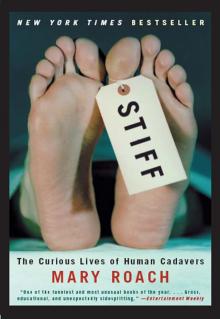 Stiff
Stiff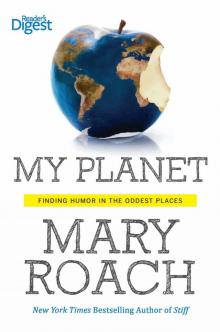 My Planet: Finding Humor in the Oddest Places
My Planet: Finding Humor in the Oddest Places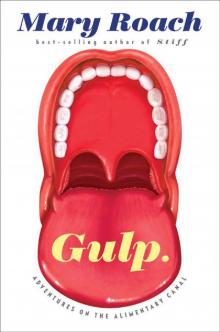 Gulp: Adventures on the Alimentary Canal
Gulp: Adventures on the Alimentary Canal The Best American Science and Nature Writing 2011
The Best American Science and Nature Writing 2011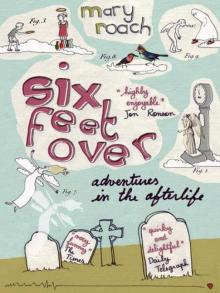 Six Feet Over: Adventures in the Afterlife
Six Feet Over: Adventures in the Afterlife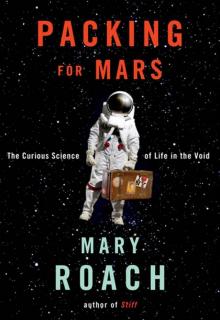 Packing for Mars: The Curious Science of Life in the Void
Packing for Mars: The Curious Science of Life in the Void Grunt: The Curious Science of Humans at War
Grunt: The Curious Science of Humans at War